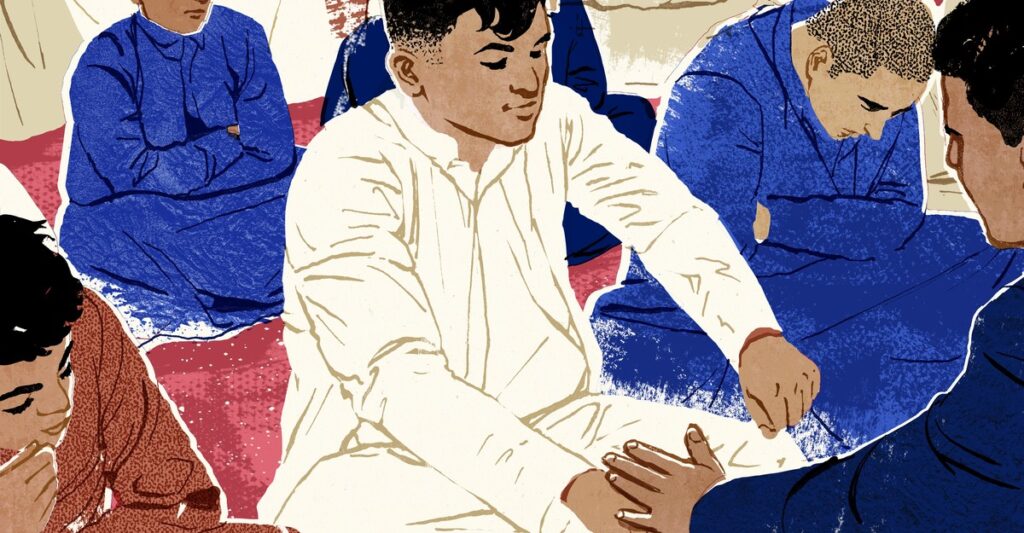By 4 a.m., a breeze had begun to blow across the stadium near the center of Baghdad, but Qaid al-Sheikhli was still sweating through his dishdasha. He was six hours into a championship quarterfinals match of mheibes, one of the world’s most challenging mental sports. His team, al-Sa’doun, was down by 10 points. The clock was running out.
When you hear the game described, mheibes doesn’t sound difficult. It sounds impossible. Assembled on the court in front of al-Sheikhli were his opponents: 45 men from the city of Najaf, arranged in three neat rows. One of these players held a silver ring. It was al-Sheikhli’s job to determine which one—and in which fist he held the ring—judging only by his facial cues and other tells.
Al-Sheikhli had already made significant progress toward this goal: He and his fellow captain had narrowed the field of suspects to four. A referee in a red vest hovered nearby with a stopwatch. Each team started with just five minutes to find the ring, per that year’s tournament rules; if that time elapsed, their opponents got the point.
Now al-Sheikhli bore down on one of the remaining defenders, a middle-aged man in a light-blue robe. “Fists and face!” he barked in Baghdadi-accented Arabic. The Najaf player stretched out his arms, fists still clenched, and lifted his head to look into the captain’s eyes. He held this pose for three seconds, as required by the tournament’s rules, while al-Sheikhli scanned his face. “Taliq! ” the captain cried, while slapping at the man’s two hands in quick succession. He thought the fists were empty, and he was right. When the man exposed his palms, al-Sa’doun fans in the bleachers rose to their feet, roaring in approval.
By narrowing the field to three men, al-Sheikhli had earned his team a bit of bonus time—two extra minutes on the clock. He huddled with his fellow captain. In several earlier rounds, they’d managed to identify Najaf’s ring bearer, but had picked the wrong hand and lost the point. “It was the Najaf fists,” al-Sheikhli told me later. “They were difficult.”
When the captains broke their huddle, al-Sheikhli called to the crowd, his arms outstretched. The al-Sa’doun fans answered with another cheer. Now he turned on one of the three remaining suspects, a young man with shaggy hair and his jacket pulled up around his neck—a common move to hide the pulsing of the carotid artery. Al-Sheikhli called for “fists and face” again, and the referee pulled back the man’s hair so that his face was fully visible. For the full three seconds, the captain stared him down. Finally, he gestured to the man’s right hand. “Jiib,” he said. Give it to me. The man opened his hand, and the stadium lights reflected, at last, on a glint of silver.
Lying is a fundamental human act, and bluffing games of one sort or another are found in cultures around the globe. Latvian children play a ring-hiding game of their own, and “hunt the slipper” was a popular hiding-and-bluffing game in Victorian parlors. Across North America, Indigenous groups enjoy a sport not unlike mheibes, in which players must find bones hidden in the fists of an opposing team.
The great U.S. contribution to bluffing games, of course, is poker, now a global industry worth approximately $100 billion. I covered poker for about a decade, and I’ve met some of the game’s virtuosos in the art of spotting tells. Even so, when I first learned about mheibes, and started poring over the match videos posted on YouTube and Facebook, I was awestruck by the captains’ skill. A poker player might need to study eight other people at their table. A mheibes captain takes stock of perhaps 45 distinct opponents—or, really, 90 different fists. Mheibes captains do not succeed at this task every time. But I came to understand that top players spot the ring with shocking regularity.
I had to see this for myself. Last year, I went to Baghdad, where the game is said to have been invented, and where it’s played, by tradition, on nights during the holy month of Ramadan, after the breaking of the fast. The details of its origins remain unclear: Some say it started in the 1500s, during the Ottoman era; others trace it back to the Abbasid caliphate many centuries earlier.
Mheibes-league officials told me the modern rules began to take shape during the 1990s, under the regime of Saddam Hussein, who made the game a symbol of the nation. The game endured even after Hussein was toppled (due in part to his own failed attempt at bluffing). Since then, the number of teams competing has grown more than tenfold, and organized tournaments, once confined to Baghdad, now pop up from Basra, in the south, to Erbil, in the north. Last year, in a groundbreaking move, the Baghdadi Museum hosted a public mheibes game for women.
My seat for the April 2024 match between al-Sa’doun and Najaf was by the judge’s desk. Sitting to my right was Jassem al-Aswad—the judge himself, a grand figure in a green dishdasha. Al-Aswad is the greatest mheibes player in living memory, and his fame among Iraqis extends beyond the game. In 2008, when the country was mired in sectarian violence, he marched a team onto the Bridge of the Imams, which connects a neighborhood that contains a holy Shiite shrine to a Sunni stronghold across the Tigris. The span had been the site of one of the Iraq War’s greatest civilian calamities, and had only just reopened. One night, al-Aswad brought out players from both sides of the river, who met up in the middle to play for peace.
Al-Aswad, now in his early 70s, seemed to enjoy his new role on the sidelines. He took evident pleasure in shouting to the fans, and playing with the kids who ran up to him with their fists closed, hoping to fool the great man. He also kibitzed with his old friend Ali al-Lami, the octogenarian retired captain of the al-Habibiya team, who sat nearby. We watched together as the teams from al‑Sa’doun and Najaf launched into the next round of their match. It was after 5 a.m. Now al-Sa’doun would hide the ring.
Supporters brought out a stretch of gold-fringed fabric to obscure the team’s choice of ring holder. In mheibes, defensive strategy is just as crucial as offense, and the placement of the ring unfolds with Masonic complexity. A team captain might put his hands over each player’s fists in turn, either placing a ring inside of one or pretending to. (If players know which teammate has the ring, they might betray that knowledge on the court.) Sometimes a captain places extra rings and steps back to scan his teammates’ faces. Have the men with rings begun to sweat? Are their fists uneven? Using all of this information, a captain makes a second pass, and perhaps a third, until he has removed all the rings but one.
When al-Sa’doun had finished and the players settled in their rows, the Najaf captains stepped onto the court. As they made their rounds among the rows of al-Sa’doun men, al‑Lami leaned across me. “Jassem,” he said to al-Aswad. “Second row. In the green, near the end. Eh? It’s him. Only I can’t tell which fist.”
“Right fist,” al-Aswad replied. “I’ve played that guy before.”
We were at least 20 feet away from the nearest player, and the man they were talking about was maybe another 30 feet from there. I squinted at the man they’d identified. My eyes, younger by decades than either al-Lami’s or al-Aswad’s, couldn’t make much out. Neither could Najaf’s star captain. When he stopped in front of the man in green to study his fists and face, he gave no sign of seeing anything unusual.
A minute or two later, the Najaf captains began eliminating players. They counted out several in the second row. But before they could continue, one of those dismissed cried out “Baat!,” which meant he had the ring. It was the man in the green dishdasha—the one al-Lami and al-Aswad had pegged from about 50 feet away. And just as al-Aswad had predicted, the ring was in his right fist.
A mheibes captain’s talent can seem miraculous, or even suspect to the non-Iraqi viewer. But if mheibes were a sham—if its matches were scripted in advance, like some kind of Iraqi WrestleMania—then the private conversation I’d just observed would have to have been prewritten too. Mheibes suggests a more compelling possibility, which is that the art of peering into people’s faces and uncovering deceit may be honed to astonishing precision.
Some researchers believe that people can be prodigies at lie detection. Other scholars aren’t sure these so-called wizards are real. Mark Frank, a communication professor at SUNY Buffalo, is in the former camp, and helped create some of the most ambitious lie-detection studies to date. But when I showed him some clips of mheibes captains’ feats, even he was taken aback. Frank wondered at the circumstances that had led them to develop such extraordinary skill. A curious pattern had emerged from the early work on wizards, he told me: A large number of them had experienced a tumultuous childhood. Some were the children of alcoholics. Later research found wizards who were raised in institutions or in violent environments. Scholars theorized that for these people in particular, the ability to read adults’ expressions when they were young might have been lifesaving. (This made me think of Jerry Yang, one of poker’s face-reading masters—and an ethnic Hmong who grew up, for a time, in a Thai refugee camp.)
The past two generations in Iraq have endured an almost unthinkable progression of wars, mass migrations, and humanitarian crises. Even in the relative calm of recent years, bombings still occur with regularity. “That,” Frank told me, “is an environment ripe for producing people who are good detectors of subtle clues.”
When I got the chance to float this theory to actual mheibes players, they were unimpressed. Mheibes has been around for longer than the recent conflicts, al-Sheikhli, al-Sa’doun’s co-captain, told me. And one generation of modern players grew up in the 1970s, when Baghdad was a mostly peaceful, modernizing oasis.
“I grew up watching other captains. I played a lot. That’s how I learned,” al-Sheikhli said. He grabbed a ring for demonstration and closed his fist around it. Then he pointed to a spot between his second and third knuckle. There’s a tendon there that fastens the dorsal interossei muscle to bone. It’s almost invisible. But al-Sheikhli said it sometimes bulges out a tiny bit when someone has the ring, and captains learn to spot it only through extensive practice. (His willingness to share this tip surprised me. Over months of interviews, I’d learned that most mheibes players won’t discuss their strategies at all.)
But even a captain’s favored methods may lose efficacy as a match wears on. Ali al-Lami warned me that mheibes changes after sunrise. Finding the ring can get more difficult, he said. Whether from the return of fasting or sheer exhaustion, players may become impassive. The captains, too, may start to wilt. One viral video on TikTok shows a captain toward the end of a 15-hour match, probing his opponents in the daytime heat, as run-down as a senator in the final moments of a filibuster.
The quarterfinals match I saw finished shortly after 9 a.m., when Najaf scored its 13th point and won the game. Fans streamed to the exits, food stalls closed, players boarded buses. Eventually, a few men came over to where I was sitting, picked up the judge’s desk, and walked it back into the small stadium office where it’s stored. If this had been a neighborhood game, the winners would have received, by tradition, a plate of sweets. In the mheibes major leagues, however, no such prize is offered. For once, all of the Najaf players were empty-handed.
This article appears in the July 2025 print edition with the headline “The World’s Hardest Bluffing Game.”
Premium IPTV Experience with line4k
Experience the ultimate entertainment with our premium IPTV service. Watch your favorite channels, movies, and sports events in stunning 4K quality. Enjoy seamless streaming with zero buffering and access to over 10,000+ channels worldwide.

















